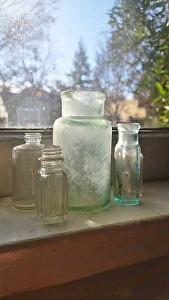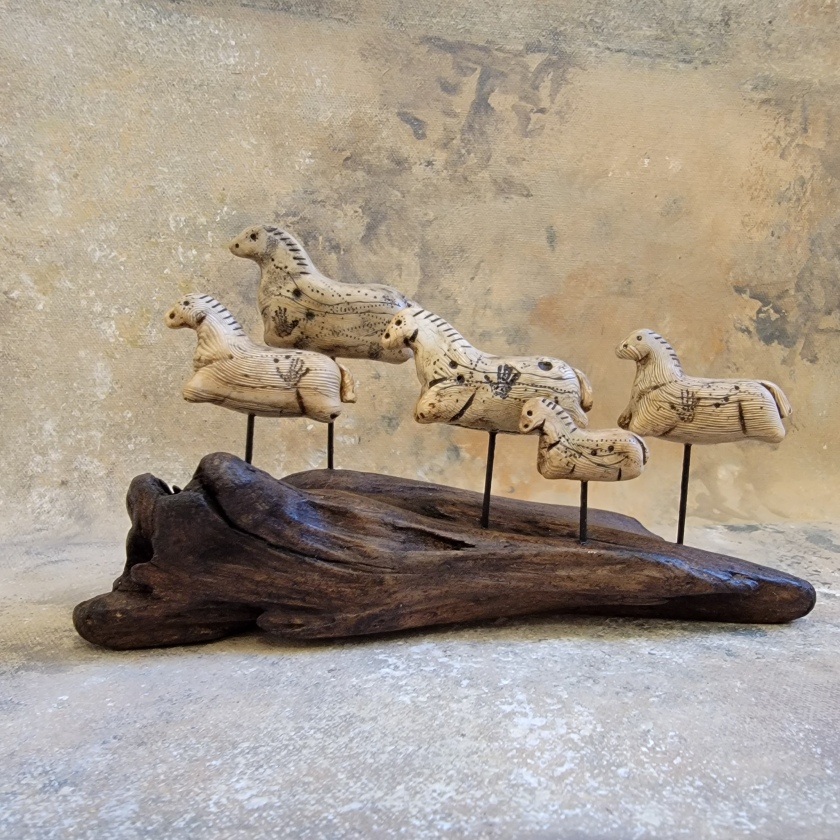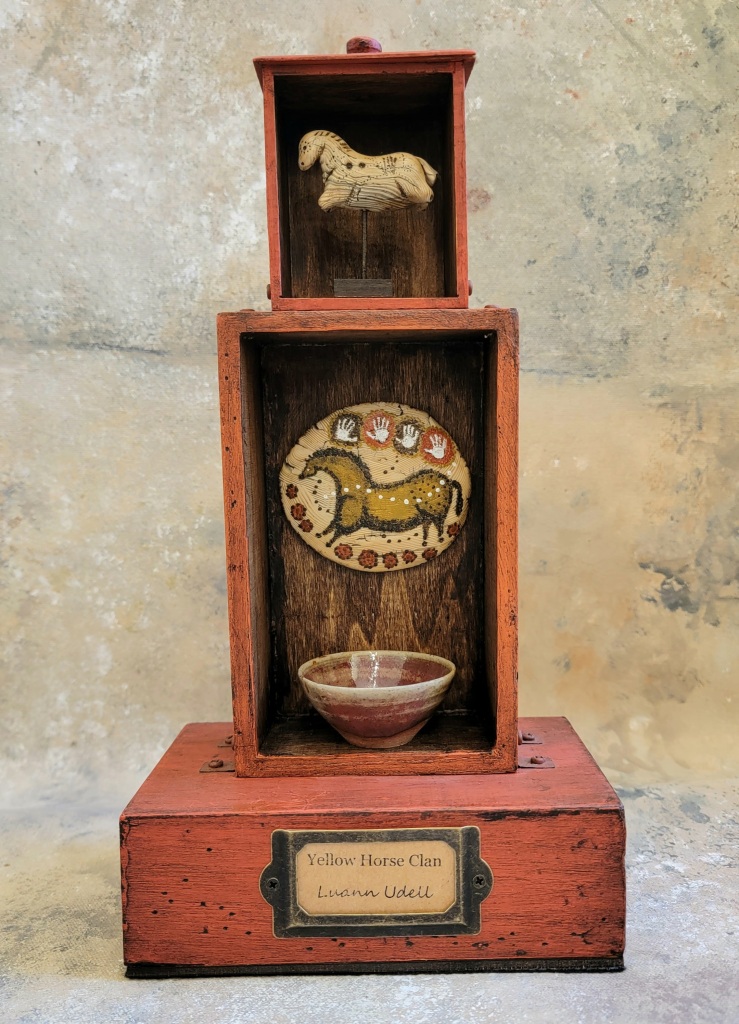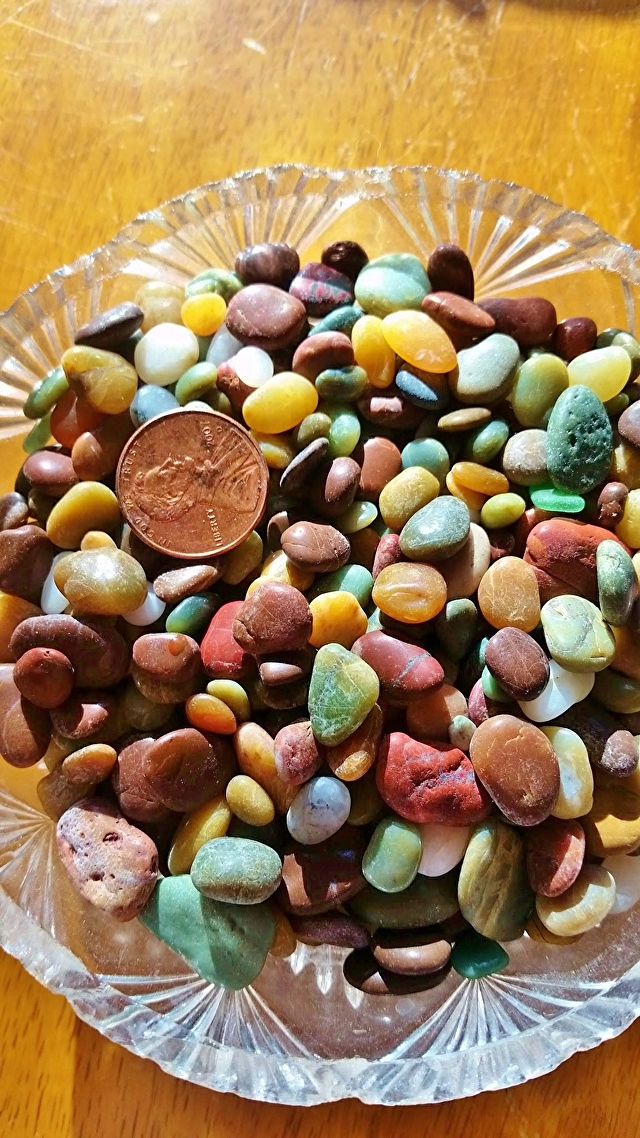This post is by Luann Udell, regular contributing author for FineArtViews. She’s blogged since 2002 about the business side–and the spiritual inside–of art. She says, “I share my experiences so you won’t have to make ALL the same mistakes I did….” For ten years, Luann also wrote a column (“Craft Matters”) for The Crafts Report magazine (a monthly business resource for the crafts professional) where she explored the funnier side of her life in craft. She’s a double-juried member of the prestigious League of New Hampshire Craftsmen (fiber & art jewelry). Her work has appeared in books, magazines, and newspapers across the country and she is a published writer.
Where is your happy place? Go there today!
I promise I will stop whining about my very hard year, but not yet. For now, it still holds many life lessons for me.
Life lessons are hard, though, especially when we love them so much, we learn them over and over and over again.
Maybe too many lessons this year? Loss. Grief. Forgiveness. Being vulnerable. Looking for the light. Leaving “the group”. Setting boundaries. Sometimes I think Brene Brown is writing just for me.
Mostly, though, I know we all struggle with who we are in the world, and who we WANT to be. Being human can be hard work. Being a good human is exhausting.
Except when it isn’t. And that’s what I want to share with you today, this holiday season.
Monday I spoke with a physical therapy person at the gym where I get (doh!) physical therapy. (I use their independent gym program. Most of the patrons are even older than I am. So at least I’m not looking at healthy, fit, beautiful youngsters working out at five times the level and six times the speed I am.)
I complained about the chronic aches and pains I’m struggling with. It never stops, and it never gets better. With everything else on my plate, it feels like injury heaped on insult. (Yes, I know I have that backwards, but it works here.)
They asked me about my activity level. I replied it’s minimal, because a) everything hurts, and b)….well, everything hurts!
They reminded me yet again that hunkering down makes everything worse. “Our bodies are made to move,” they said. “When was the last time you went for a walk?”
Er…..can’t remember???
All of us have some discomfort, or ache, or even pain. We all want a very simple solution: All of us want a pill to make it better.
A temporary fix, in most cases. And we all know the dangers of self-medicating. It helps for awhile. And then it doesn’t. Then the self-medicating creates its own problems.
So….no pill?! Dang.
“Go for a walk,” they said. “If you can’t walk for 30 minutes, walk for 10 minutes three times a day. It’s not how long, or how hard, or how fast you do it. It all counts. Try it.”
Honestly, I wanted to cry. I want my simple, easy solution! It hurts to move! EVERYTHING hurts—my body, my feelings, my conscience, my spirit. I want to be distracted from my problems! I want to watch endless TV in comfort!! I want my Christmas cookies!!!
“Everybody hurts somewhere”, they said, with compassion. (The compassion part almost made me cry.) “Just try it.”
Fortunately, the next day was a beautiful, sunny day, a rare break from the winter’s rain. It was Christmas Day, but with no family here, a tight budget, a tiny tree that took 10 minutes to set up, there wasn’t much to do at home.
Remembering those words of wisdom, my husband and I went for a walk. Not a big walk. Just a walk through our neighborhood, but a new route. It’s a tradition we had back in Keene NH, where we would walk downtown every morning for coffee before we both started our day.
We’ve skipped that for years now. No coffee shop. Jon starts his day early, to catch up with co-workers on the East Coast.
We’ve missed it. So we walked.
It was great! We talked. The dogs explored new bushes to pee on. We imagined ourselves living in the pretty little houses with wonderful gardens. That garage could be a new studio! That house has a lemon tree! Wow, smell those roses!!!
We agreed it needs to be part of our day again.
I went to my normally-best happy place, my studio, to work. Unfortunately, it’s not my happy place lately. My future there is in upheaval, and everything there reminded me of that.
And yet….
I thought if I had more tiny wind-swept beach pebbles, I could use them to add a delightful accent to an assemblage I’m working on for an upcoming solo exhibition.
I remembered there are tiny, wind-polished beach pebbles on a beach at Point Reyes.

I’m a pebble puppy, and I’m proud!
I realized we had enough daylight left to drive out there.
I had a mission! And a clear destination. Fortunately, my hubby agreed, and off we went.
The drive to Point Reyes is exquisitely beautiful. Rolling grazing land with old valley oaks, amazing vistas, all bright green with the recent rains, and big blue sky. One of our joys as a couple is taking drives to amazing places.
There are many things that are difficult in California: The cost of living, the cost of housing, the woes that high-tech industries bring to big cities, wildfires, earthquakes, mudslides, I could go on.
But almost everywhere you go, there is jaw-dropping beauty. The mountains, the redwood forests, the deserts, the Pacific Ocean….
The ocean will take every ounce of your sorrow and sadness, your fears and self-doubt, and it will sweep them away.
The ocean here along the Central Coast and in Northern California is powerful, and dangerous. It’s not the gentle wash of the mid-Atlantic, nor the calm surface of a lake. You have to watch your back. Rip tides, king tides, sneaker waves, sudden storms, all await the careless or the unwary.
And yet watching waves roll in is strangely calming. It is unrelenting, never stops. It doesn’t wait for me, nor you. It is its own “thing”, with its own rules and purpose. It is totally unpredictable, yet always powerful…and astoundingly beautiful.
Kinda like life, huh?
We walked. Soon I found those special rocky patches in the sand, where small polished pebbles can be found. Jade, serpentine, jasper, carnelian, quartz, in shades of olive, sage, pine green, red, orange, amber, white, black, and brown. I happily hunted-and-gathered for over an hour, collecting about a cup of tiny stones.
I felt my heart slowly edge back into place, and my soul, just as slowly, open up a little.
The drive back was just as beautiful. Soaring vultures, diving hawks, sentinel herons, crows and starlings gathering in the dusk, a flock of bluebirds. Bluebirds! And gorgeous glowing pink cumulus clouds holding the last rays of the sunset….
We humans are hard-wired to be hunter-gatherers. Whether we emulate that in picking up pretty pebbles, collecting tools and brushes, teacups, Chilean cabernets, the sale rack at Nordstrom’s or the local flea market, it’s in us somewhere.
We are also hard-wired to pay attention to the horizon. Our ancestors watched for signs of danger. That evolved into being constantly aware of our surroundings. Our love of beautiful views and beautiful places, whether they are mountains and mesas or small gardens and sweet cottages, spring from this. We are soothed by sights, scenes, and vistas. (Landscape artists, are you listening?)
We are hard-wired to watch the sky. Is a storm coming? Is the day waning? Weather meant life-or-death to our ancestors. Still does, though more of an inconvenience for most of us, most of the time. Yet a beautiful sky is still a mood-lifter.
We are also hard-wired for water. A small babbling brook, a roaring waterfall, a koi pond (or aquarium!), a lake, even a bird bath, is a universal source of interest, comfort, amusement. But the ocean tops them all.
Me? I also have a superpower. I sort. I will enjoy some time picking through these pebbles today, sorting by color and size. (They need to fit into a tiny bottle!) I find sorting very soothing. Er….after I’m done screaming when I’ve knocked a box of beads onto the floor…

Got any little old crusty bottles you don’t want? (My version of “you gonna eat that?”)
As I work today in my studio, I will remember the wild storm surf, the wind, the big sky, deer and cattle, birds and clouds. And a handful of carefully gathered and curated pebbles. Oh, and all those times I spent collecting lovely little old glass bottles in New Hampshire antique stores….
If you are struggling this holiday season, if you are sad, or lonely, or fearful, if you are stressed, or grieving, take exquisite care of yourself.
If even your sacred creative space is (temporarily, I hope!) compromised, take heart. You will get through this.
It will never stop aching. But the sharp pain will (hopefully) soften. Time, love, friendship, solace, music, nature, will help you heal.
Seek out what brings you joy, and peace in your heart.
Find the beauty of the world. Let it heal you.
Then, when you are rested and restored to yourself, take up your tools again: Your pencils, your brushes, your pile of clay. Sit again at your loom, your easel, your worktable. Put on your favorite music, or sit with silence.
Share what healed you today. Capture it and share it, so someone else can be healed, too.
It’s what we artists do.
And we are really, really good at it, too. Thank heaven!























